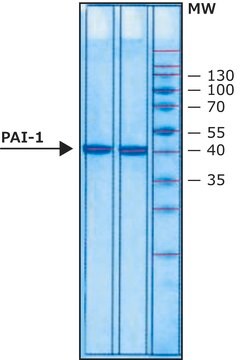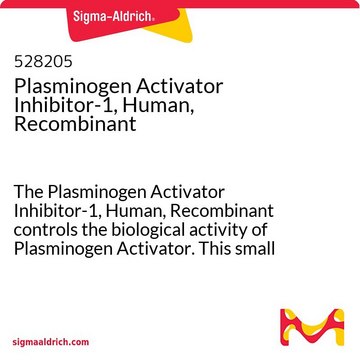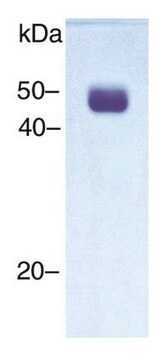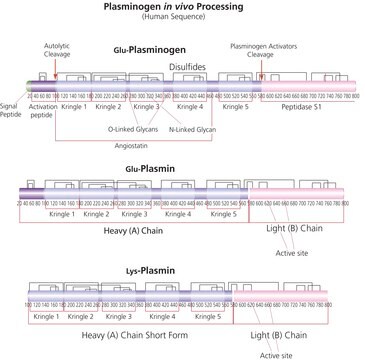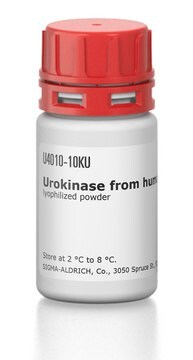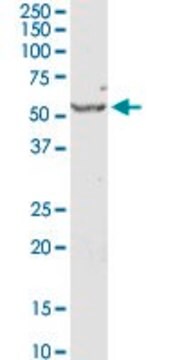推荐产品
生物源
human
重組細胞
expressed in E. coli
化驗
≥95% (HPLC)
≥95% (SDS-PAGE)
形狀
lyophilized
分子量
60 kDa
包裝
pkg of 10 μg
技術
cell culture | mammalian: suitable
雜質
<0.1 EU/μg endotoxin, tested
顏色
white to off-white
UniProt登錄號
運輸包裝
wet ice
儲存溫度
−20°C
基因資訊
human ... SERPINB2(5055)
一般說明
PAI-2 is an inhibitory serpin expressed mainly in keratinocytes, activated monocytes, and placental trophoblasts. It exists predominantly as a 47 kDa nonglycosylated intracellular protein which can be induced to be secreted as 60 kDa glycoprotein. The glycosylated and unglycosylated forms of PAI-2 are equally effective as inhibitors of urokinase-type plasminogen activator (uPA), the only established physiological target of this serpin. . PAI-2 has a unique ability to form dormant polymers spontaneously and reversibly under physiological conditions. The physiological relevance of this property, which is neither a consequence of any mutation in the PAI-2 gene nor associated with any known disorder, is still unclear. However, it appears that the formation of intracellular dormant polymers may be important for the controlled release of the inhibitor from PAI-2 producing cells. Plasma levels of PAI-2 are usually low or undetectable, except during pregnancy and in some forms of monocytic leukemia. Secretion of PAI-2 from the placenta normally occurs during the third trimester of pregnancy and accounts for the dramatic increase in PAI-2 levels (up to 250 ng/ml), which are maintained at these levels until postpartum, and then rapidly decline. In addition to its vital role in protecting the placenta from degradation by uPA and/or uPA-activated proteases, PAI-2 has been shown to be essential for the prevention of metastatic spread of neck, lung and breast cancers. The beneficial effect of PAI-2 seen in these studies is presumed to stem from its ability to inhibit uPA-dependent cell dissemination. PAI-2 has also been reported to inhibit keratinocyte proliferation, and to participate in the innate immune response during viral infection. Recombinant human PAI-2 is a 415-residue nonglycosylated protein.
生化/生理作用
PAI-2 is an inhibitory serpin expressed mainly in keratinocytes, activated monocytes, and placental trophoblasts. It exists predominantly as a 47 kDa nonglycosylated intracellular protein which can be induced to be secreted as 60 kDa glycoprotein. Recombinant human PAI-2 is a 415-residue nonglycosylated protein.
序列
MEDLCVANTL FALNLFKHLA KASPTQNLFL SPWSISSTMA MVYMGSRGST EDQMAKVLQF NEVGANAVTP MTPENFTSCG FMQQIQKGSY PDAILQAQAA DKIHSSFRSL SSAINASTGN YLLESVNKLF GEKSASFREE YIRLCQKYYS SEPQAVDFLE CAEEARKKIN SWVKTQTKGK IPNLLPEGSV DGDTRMVLVN AVYFKGKWKT PFEKKLNGLY PFRVNSAQRT PVQMMYLREK LNIGYIEDLK AQILELPYAG DVSMFLLLPD EIADVSTGLE LLESEITYDK LNKWTSKDKM AEDEVEVYIP QFKLEEHYEL RSILRSMGME DAFNKGRANF SGMSERNDLF LSEVFHQAMV DVNEEGTEAA AGTGGVMTGR TGHGGPQFVA DHPFLFLIMH KITNCILFFG RFSSP
外觀
Lyophilized from 10 mM Tris pH 8.0 + 1 mM Cysteine.
重構
Centrifuge the vial prior to opening. Reconstitute in water to a concentration of 0.1-1.0 mg/ml. Do not vortex. This solution can be stored at 2-8°C for up to 1 week. For extended storage, it is recommended to further dilute in a buffer containing a carrier protein (example 0.1% BSA) and store in working aliquots at -20°C to -80°C.
儲存類別代碼
11 - Combustible Solids
水污染物質分類(WGK)
WGK 3
閃點(°F)
Not applicable
閃點(°C)
Not applicable
Benjamin Brenner
Thrombosis research, 114(5-6), 409-414 (2004-10-28)
In normal pregnancy, there is a marked increase in the procoagulant activity in maternal blood characterized by elevation of factors VII, X, VIII, fibrinogen and von Willebrand factor, which is maximal around term. This is associated with an increase in
Robert L Medcalf et al.
The FEBS journal, 272(19), 4858-4867 (2005-09-24)
Plasminogen activator inhibitor type-2 (PAI-2) is a nonconventional serine protease inhibitor (serpin) with unique and tantalizing properties that is generally considered to be an authentic and physiological inhibitor of urokinase. However, the fact that only a small percentage of PAI-2
我们的科学家团队拥有各种研究领域经验,包括生命科学、材料科学、化学合成、色谱、分析及许多其他领域.
联系技术服务部门
